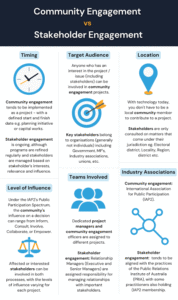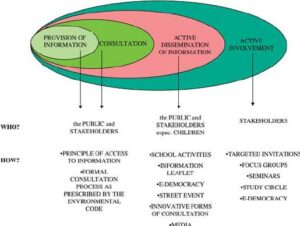Back to: Environmental Biology 500 Level
Welcome to class!
Hello, my ever-curious friend! I’m truly happy to have you here again. Today’s lesson is very special because it talks about people—yes, real people like you, your parents, your lecturers, your community leaders, and even the roadside food vendor. We’re discussing Public Participation and Stakeholder Engagement in the Environmental Impact Assessment (EIA) process. This is where the voices of everyday Nigerians are heard in decisions that affect their environment, health, and future. So, let’s talk like family—no big grammar, just real-life understanding.
Public Participation And Stakeholder Engagement
What is Public Participation in EIA?

Public participation means giving the people who will be affected by a project the chance to be involved in the decision-making process. It is a way of saying, “This is your land, your water, your air—you have the right to speak up.”
In EIA, it involves sharing information about the proposed project, listening to concerns, and including local knowledge to help shape better environmental decisions.
Who are Stakeholders?
Stakeholders are all the people, groups, or organisations who have an interest in or could be affected by a project. They can include:
Local community members
Traditional rulers and elders
Government agencies (like NESREA and the Federal Ministry of Environment)
Environmental NGOs
Project developers and consultants
Farmers, fishermen, youth groups, and even religious leaders

Example:
Imagine a large cement factory is planned for a rural community. Stakeholders would include the villagers who live nearby, the school children who may breathe in dust, the farmers whose crops might be affected, and government regulators.
Why Public Participation Matters
It builds trust – When people feel included, they are more likely to support the project.
It reveals local knowledge – Community members often know important things like sacred lands, water sources, or seasonal flooding.
It reduces conflict – Involving people early helps avoid protests or delays later on.
It promotes fairness – It gives a voice to the people who may not usually have one.
How Public Participation Happens in EIA
Public notices and announcements – Usually through local radio, town criers, posters, or community meetings.
Public hearings – A formal gathering where people ask questions and share concerns.
Focus group discussions – Smaller meetings with key community groups like youth, women, or farmers.

Questionnaires and surveys – To collect opinions from a wide range of people.
A Nigerian Example
Before building the Zungeru Hydroelectric Power Project in Niger State, public consultations were held with surrounding communities. People shared how they depend on the river for fishing, farming, and daily living. This helped the planners adjust parts of the project and offer relocation support.
Summary
- Public participation means involving people in environmental decisions that affect them.
- Stakeholders include anyone who has an interest in or may be impacted by a project.
- It builds trust, reveals local knowledge, reduces conflict, and promotes fairness.
- Methods include public hearings, community meetings, and surveys.
Evaluation
- What is public participation in the context of EIA?
- List four examples of stakeholders in a Nigerian community project.
- Why is local knowledge important in environmental planning?
- Mention two methods used to engage the public in the EIA process.
Well done, superstar! You’ve just learned a powerful truth—development must involve people, not just machines and money. Keep asking questions, keep learning, and keep shining. Afrilearn is here with you all the way. See you next class, and don’tforget—you have a voice that matters!
